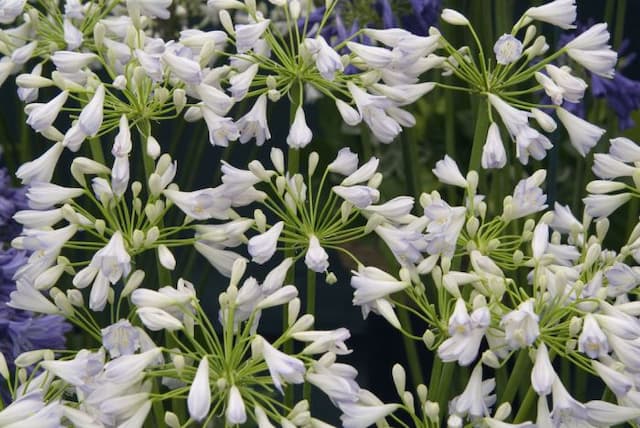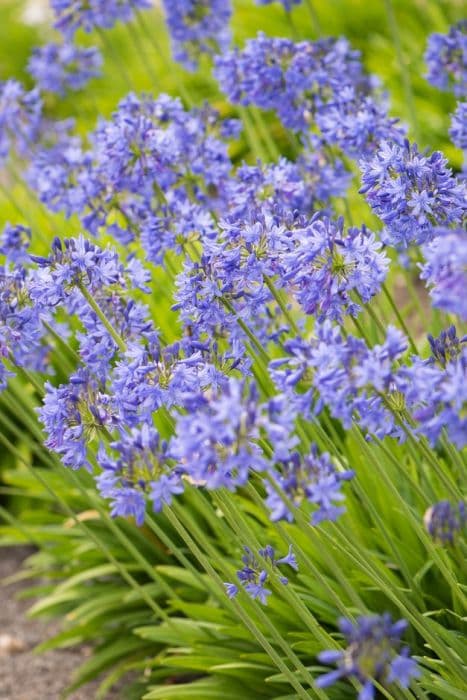African Lily Agapanthus 'Phantom'

ABOUT
The Agapanthus 'Phantom', commonly known as the African Lily or Lily of the Nile, is a striking perennial that is characterized by its showy flowers and lush foliage. The plant features clusters of beautiful white flowers that bloom atop tall, sturdy stalks. These blossoms are trumpet-shaped and come together to form a round or umbel-like cluster, which gives a breathtaking display when they are in full bloom. The African Lily's flowers present a subtle gradation of color, often starting with a pale color at the edge of the petals and deepening to a hint of blue or violet at the base, giving them a delicate, ethereal appearance. The blossoms are known for their long-lasting qualities, both on the plant and as cut flowers in arrangements. Below the flowers, the plant boasts generous tufts of strap-shaped leaves. These leaves are dark green in color and arch gracefully, forming a dense clump of foliage at the base of the stalks. The contrast between the soft texture of the leaves and the elegant flowers adds to the ornamental value of the Agapanthus 'Phantom'. Overall, the African Lily 'Phantom' presents a harmonious and elegant appearance, making it a favored choice for gardeners looking to add a touch of sophistication to their beds, borders, or as a statement in patio containers. Its attractive blooms and lush greenery create a focal point wherever it is planted, without the need to reference specifics of its dimensions.
About this plant
 Names
NamesFamily
Amaryllidaceae
Synonyms
Lily Of The Nile, African Lily, Pharaoh's Flower
Common names
Agapanthus 'Phantom'
 Toxicity
ToxicityTo humans
The Agapanthus, commonly known as Lily of the Nile, is considered mildly toxic if ingested. The plant contains substances that can cause gastrointestinal symptoms such as nausea, vomiting, and diarrhea. In some cases, ingesting parts of the Agapanthus can also result in allergic reactions or skin irritation.
To pets
The Lily of the Nile is also toxic to pets if ingested. The symptoms of poisoning in pets can include nausea, vomiting, and diarrhea, similar to the effects on humans. In more severe cases, it can also cause drooling, lethargy, and an increase in heart rate. It is important to prevent pets from consuming any part of the plant to avoid these potential health issues.
 Characteristics
CharacteristicsLife cycle
Perennials
Foliage type
Evergreen
Color of leaves
Green
Flower color
White
Height
2-3 feet (60-90 cm)
Spread
2 feet (60 cm)
Plant type
Bulb
Hardiness zones
8
Native area
South Africa
Benefits
 General Benefits
General Benefits- Easy to Care For: The Agapanthus 'Phantom' is known for its low maintenance requirements, making it suitable for gardeners of all experience levels.
- Drought Tolerant: Once established, it is quite drought-resistant and can thrive with minimal watering, which is beneficial in water-scarce regions or during water restrictions.
- Attractive Blooms: It produces striking white flowers that can add beauty and elegance to any garden or landscape setting.
- Long Blooming Period: The blooming season of Agapanthus 'Phantom' is relatively long, often providing flowers throughout the summer months.
- Pest Resistant: This plant is fairly resistant to pests, reducing the need for chemical treatments and making it a more eco-friendly choice.
- Deer Resistant: It is typically not a favorite of deer, which can be particularly beneficial in areas where deer predation is a problem for other plants.
- Good for Cut Flowers: The flowers of Agapanthus 'Phantom' are excellent for cutting and including in floral arrangements due to their long stems and striking appearance.
- Attracts Pollinators: The plant can attract beneficial insects such as bees and butterflies to the garden, which are important for pollination and the health of the local ecosystem.
- Soil Versatility: Agapanthus 'Phantom' can tolerate a range of soil types as long as they have good drainage.
- Container Gardening: It is suitable for container gardening, allowing for flexibility in placement and the ability to grow the plant on patios, balconies, or other spaces where ground planting is not an option.
 Medical Properties
Medical PropertiesThis plant is not used for medical purposes.
 Air-purifying Qualities
Air-purifying QualitiesThis plant is not specifically known for air purifying qualities.
 Other Uses
Other Uses- Photographic Subject: Agapanthus 'Phantom' provides a dramatic and appealing subject for photographers, especially macro photography enthusiasts, due to its intricate flower structure.
- Dye Source: The blooms of the Agapanthus can be used to create natural dyes for fabrics, yielding shades of blue and purple depending on the mordants used.
- Artistic Inspiration: Artists often use the striking form of Agapanthus flowers as inspiration in paintings, illustrations, and textile designs, capturing their unique shape and vibrant colors.
- Culinary Garnish: Although not a common practice, the blooms of Agapanthus can be used as an ornamental garnish for plating high-end cuisine due to their visual appeal.
- Education and Research: Agapanthus 'Phantom' can serve as an educational tool for botany students studying plant anatomy, life cycles, and pollination strategies.
- Erosion Control: The robust root system of Agapanthus helps stabilize soil and prevent erosion on slopes and embankments.
- Water Garden Accent: This plant can be used in water garden designs to add a structural element and its tall stature can provide vertical interest.
- Wedding Decor: Fresh or dried Agapanthus flowers are sometimes incorporated into wedding bouquets or as part of the venue decorations for their elegant and stylish appearance.
- Companion Planting: Agapanthus can be used in gardens to complement other plants, offering a contrast in texture and color that can enhance the overall aesthetic of a planting scheme.
- Marker Plant: Because they are easily identifiable and maintain a consistent size, Agapanthus can serve as a natural marker in garden designs or as a way to signify boundaries or divisions within landscape designs.
Interesting Facts
 Feng Shui
Feng ShuiThe African Lily is not used in Feng Shui practice.
 Zodiac Sign Compitability
Zodiac Sign CompitabilityThe African Lily is not used in astrology practice.
 Plant Symbolism
Plant Symbolism- Love Letters: Agapanthus, commonly known as Lily of the Nile, is often associated with love and is sometimes regarded as a symbol of love letters or messages.
- Beauty: The striking beauty of the Agapanthus blooms often symbolizes an appreciation of beauty and the elegant aspects of life.
- Purity: The often blue or violet-blue flowers can represent purity and innocence, similar to the connotations associated with the color blue.
- Enduring Love: Due to its perennial nature, Agapanthus can symbolize enduring or long-lasting love, as the plant returns year after year.
 Water
WaterLily of the Nile requires thorough watering every week or two during the growing season, ensuring that water penetrates deeply into the soil to encourage deep root growth. It's crucial to allow the soil to dry out between waterings, as too much water can lead to root rot. During peak summer heat, water needs may increase, especially for container-grown plants, which may require watering every few days. Provide about 1 to 1.5 gallons of water per plant per watering session, adjusting the amount according to weather conditions and the plant's size.
 Light
LightLily of the Nile thrives in full sunlight but can tolerate partial shade. The ideal spot would be a location where it receives at least six hours of direct sunlight daily. The intense morning light is preferable, with some protection from the harsh afternoon sun, especially in hotter climates.
 Temperature
TemperatureLily of the Nile prefers temperate climates and can tolerate a temperature range between 50°F and 90°F. It is hardy in zones 8 through 11 and can survive brief periods of colder temperatures down to about 20°F. The ideal temperature range for optimal growth is between 60°F and 75°F.
 Pruning
PruningLily of the Nile should be pruned to remove spent flower stalks and encourage a tidy appearance and rebloom. Pruning is best done after flowering has finished and before new growth begins in spring. It can be pruned annually, and dead or damaged leaves should be removed to maintain plant health. The best time for a major cleanup is late winter or early spring before the onset of new growth.
 Cleaning
CleaningAs needed
 Soil
SoilThe best soil mix for Lily of the Nile (Agapanthus 'Phantom') should be fertile, well-draining, and should have a pH between 6.0 and 8.0. A mixture of loam, coarse sand, and organic matter like compost or peat will create an ideal environment. Adequate drainage is crucial to prevent root rot.
 Repotting
RepottingLily of the Nile should typically be repotted every 2 to 3 years in spring or early summer. It is best to repot when the plant has outgrown its current container or when the soil becomes compacted, thus inhibiting the growth.
 Humidity & Misting
Humidity & MistingLily of the Nile thrives in moderate humidity levels; however, it is fairly adaptable and can tolerate both low and high humidity environments. It does not require any special humidity considerations as long as it's watered appropriately.
 Suitable locations
Suitable locationsIndoor
Place in bright, indirect light and water moderately.
Outdoor
Plant in full sun to partial shade, water regularly.
Hardiness zone
8-11 USDA
 Life cycle
Life cycleThe life cycle of the Lily of the Nile 'Phantom' starts with germination, which occurs when the conditions are right, typically in spring with consistent moisture and warmth. Following germination, the seedling grows into a juvenile plant, developing a strong root system and foliage. As it matures, the plant enters the vegetative stage, during which dense clumps of strap-like leaves expand and the root system becomes more established. The next stage is the flowering period, which typically takes place in summer, when tall stalks rise above the foliage, capped with clusters of trumpet-shaped, white to pale lavender flowers. Post pollination, if conditions permit, the plant may produce seed capsules that eventually dry and release seeds, allowing for the continuation of the cycle. After flowering, the plant enters a period of dormancy in the cooler months, conserving energy for the next growing season.
 Propogation
PropogationPropogation time
Early spring
The popular method of propagation for the Agapanthus 'Phantom', commonly known as Lily of the Nile, would be by division. This perennial plant tends to form clumps which can be divided to produce new plants. The best time to divide Agapanthus is in the spring after the threat of frost has passed but before the plant has put on too much growth. To divide the plant, carefully dig up the clump, keeping a good amount of soil around the roots. Use a sharp spade or knife to separate the clump into smaller sections, each with at least one or two growing points or shoots. The divisions can then be replanted immediately at the same depth they were growing before and watered thoroughly. Typically, it's suggested to space the divisions about 18 inches (approximately 45 centimeters) apart to allow ample room for future growth.









